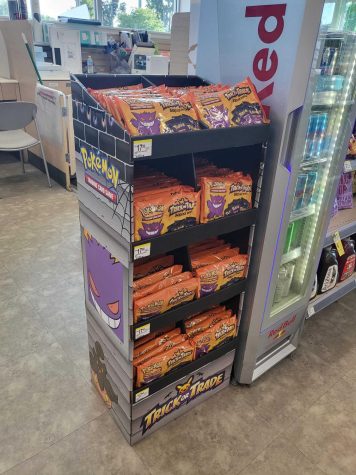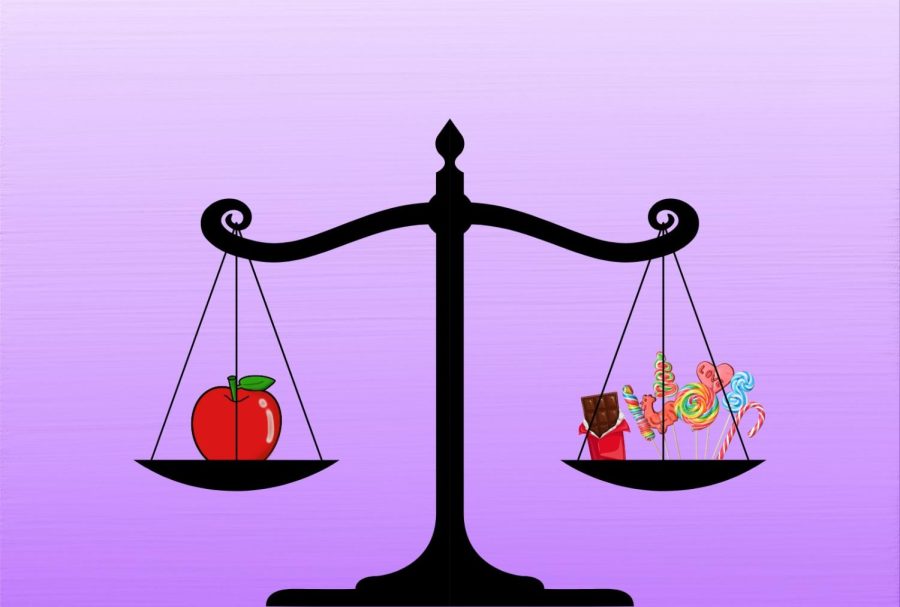Traditional Candy: Treats or Tricks?
Should Halloween candy be replaced? A COD student wanting to be a high school teacher and COD’s dental hygienist professors weigh in.
October 31, 2022

Walking towards the checkout lane of Walgreens in the beginning of September, I spotted a display of bulk packages of Pokemon cards. Upon closer inspection, I realized that the Pokemon cards were for trick-or-treaters. Seeing the cards made me wonder what other alternatives to Halloween candy there could be and, more importantly, why candy for Halloween might need to be replaced or supplemented.
One downfall of eating a ton of candy on Halloween seems to be getting a lot of cavities. Lori Drummer, the dental hygienist program chair at COD, explained that cavities do not form in a single Halloween night.
“Cavities take time to form,” Drummer said. “What’s important is that [children] brush after eating the candy, and if they’re not in a place where they can brush their teeth, at least rinse with water.”
Drummer went on to explain how to habitually avoid cavities.
“You want to bring the pH of the mouth back to neutral,” Drummer said. “Sweets will make the environment [of the mouth] more acidic. That’s what causes the breakdown of the enamel. It’s better to eat [the candy] all at once, rather than to take a bite and put it down. Eat it, pH drops, it’ll come back up, and then you’re fine.”
Barbara Czahor, a dental hygienist professor at COD, advised eating candy right after a meal to keep the changes in pH at a minimum. Interestingly, she recommended rinsing with water right after eating candy but not brushing for at least 20 minutes to allow the acid production after consuming sugar to run its course.
Marliene Tobin, another dental hygienist professor at COD, added that the type of candy also contributes to the likelihood of forming a cavity. For instance, candy that sticks to your teeth is more likely to cause cavities. Tobin said chocolate is the better option in terms of candy since it melts and does not linger.
Candy is not only a problem for the person consuming it, but for the people supervising the children eating it.
Matthew Kimball, a student at COD who aims to teach history for middle to high school students, has been around children for a long time. His mother works for a daycare, and he has been a student teacher at Blackhawk Middle School for about a year. Kimball weighed in on how he would politely but firmly try to keep candy from distracting children who brought it into his class.
“I would just straight up tell them, ‘Can you please put that back in your locker or away for the day, because, you know, it’s not lunchtime,’” Kimball said. “They’ll be eating it over my lesson. They’re more concerned about acting crazy than paying attention to my class.”
Despite not wanting kids to eat candy in class when they aren’t supposed to, Kimball is not opposed to them getting candy in general. Kimball was once given an alternative to candy during his own trick-or-treating days that he didn’t like very much.
“The most negative thing I ever got was a crappy apple,” Kimball said. “I didn’t know what to do with it. We did the age-old tradition with my friend group of trading candy. No one touched the apple.”
Unfortunately for Kimball, Tobin and Czahor agree that whole apples are excellent for children’s teeth.
“[An apple] has its natural sugar, it actually has fiber in it, and chewing crunchy foods stimulates saliva flow,” Tobin says. “When you have an adequate saliva flow, that helps to keep things from sticking to your teeth.”
Czahor, going the extra mile, is dressing up as Snow White for Halloween and giving all of her students apples.
“When I was a little kid, I did not have this information,” Czahor says. “So I ended up with a bazillion cavities and bazillions of problems. I’m waiting for implants right now. Maybe that’s why I’m so passionate about it, because I’ve been there and I’m trying to prevent it for somebody else.”
Kimball said that some alternatives to giving out candy at the daycare his mom works for included taking group pictures with everyone in their costumes, painting pumpkins and coloring festive wooden cutouts such as scarecrows.
Although candy for Halloween is not going away anytime soon, for anyone who wants other options to give trick-or-treaters, Drummer suggests popcorn. Czahor is already giving out apples. Tobin wasn’t quite ready to let go of the tradition.
“If I had to pick an alternative to candy? That’s horrible,” said Tobin. “We’re giving out full-size candy bars at my house.”
Czahor, Drummer, Kimball and Tobin all agreed that candy shouldn’t go away as long as it is enjoyed in moderation. Some of us can give out Pokemon cards, apples and popcorn while everyone else gives out the same old goodies as every other year. Just eat wisely, folks.




















